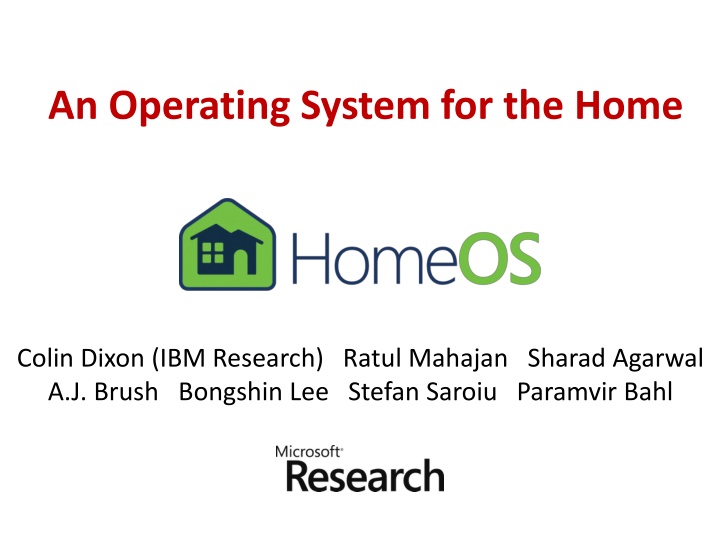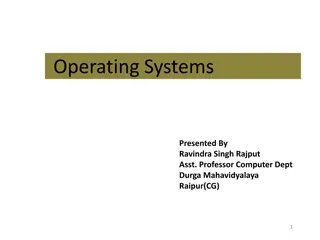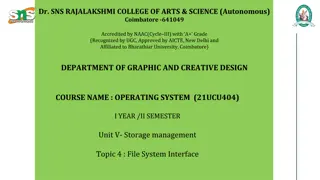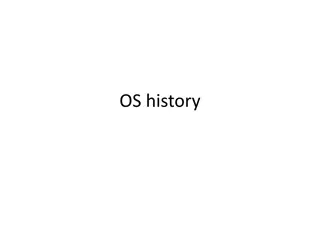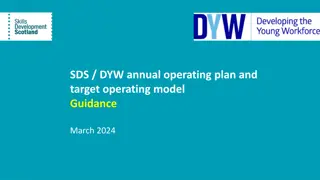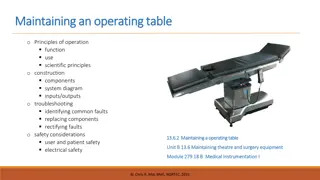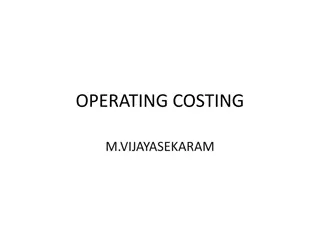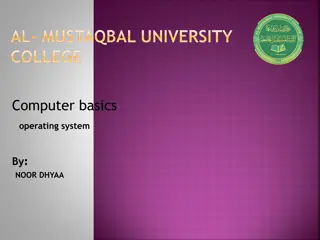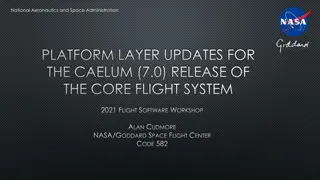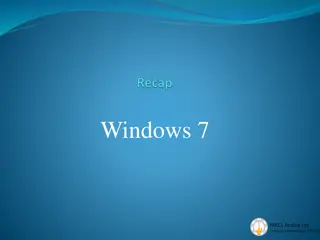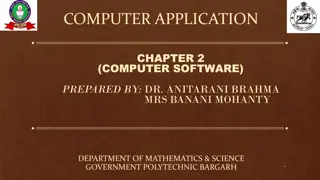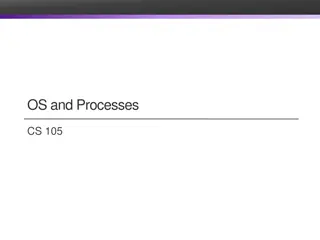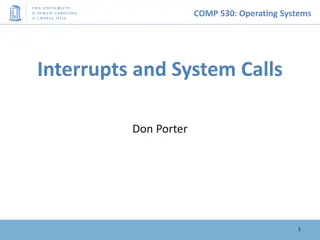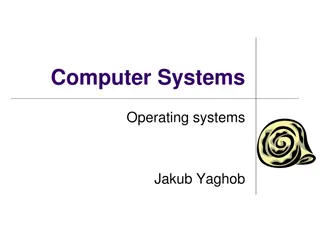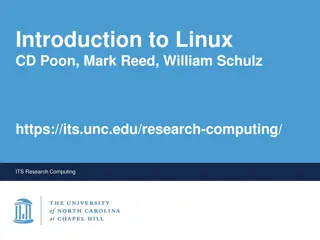An Operating System for the Home
In the realm of smart home technology, there exists a gap between potential and reality. The Home Operating System aims to address this by offering a PC-like organization for managing tech in homes. This innovative system simplifies management, enhances extensibility, and has been tested in real homes. The gap identified in modern automation involves challenges like hardware inflexibility, poor extensibility, and security management. The system seeks to bridge this divide and revolutionize smart homes.
Uploaded on Feb 21, 2025 | 2 Views
Download Presentation

Please find below an Image/Link to download the presentation.
The content on the website is provided AS IS for your information and personal use only. It may not be sold, licensed, or shared on other websites without obtaining consent from the author.If you encounter any issues during the download, it is possible that the publisher has removed the file from their server.
You are allowed to download the files provided on this website for personal or commercial use, subject to the condition that they are used lawfully. All files are the property of their respective owners.
The content on the website is provided AS IS for your information and personal use only. It may not be sold, licensed, or shared on other websites without obtaining consent from the author.
E N D
Presentation Transcript
An Operating System for the Home Colin Dixon (IBM Research) Ratul Mahajan Sharad Agarwal A.J. Brush Bongshin Lee Stefan Saroiu Paramvir Bahl
My opening statements What is the problem? Crystal clear paper Honest Novel mesh of known abstractions Concluding comments with brain teasers I have a nice set of HomeOS papers
HomeOS PC-like organization for tech in the home Ease management and extensibility Running in 12 real homes for 4 8 months Used by 42 student developers at 10 institutions
Wheres my smart-home? Tasks (software) Energy monitoring Alerts w/Photos Climate control Keyless entry Remote lock Devices (hardware)
Gap between potential and reality Smart House Poster See Who's Creating the User Interfaces of Tomorrow Envisioned by many researchers and companies Struggling to break into the mainstream Despite commercial availability since 1970s
Understanding the gap Pre-Study of homes with modern automation 31 people across 14 households Enjoyed convenience, peace of mind and control But, had difficulty in two key areas: Poor extensibility Management pain or Adding devices and tasks Access control
Gap Details Hardware inflexibility: networking wires, low- voltage wiring Extensibility: Organic growth Management: Security Currently the choice is between security and inconvenience (guest / remote access)
Gap Span of our work Hardware inflexibility: networking wires, low- voltage wiring Extensibility: Organic growth Management: Security Currently the choice is between security and inconvenience (guest / remote access)
Existing abstractions for home tech Network of devices Interoperability protocols DLNA, Z-Wave, Speakeasy, Open, low-level device access Developers must deal directly w HW Management is still hard Users must manage each device/task Appliance Monolithic systems Crestron, Control4, EasyLiving, Fixed tasks over fixed devices Closed set of devices Remote monitoring Climate control Extensibility is still hard Closed set of tasks
The home as a PC View the home as a computer Networked devices peripherals (w/drivers) Tasks over these devices applications Adding devices plugging in a peripheral Adding tasks installing an application Managing networked devices managing files
HomeOS: An OS for the home HomeStore Video recording Remote unlock Climate control HomeOS Z-Wave, DLNA, UPnP, etc. HomeOS logically centralizes all devices Users interact with HomeOS, not individual devices HomeStore helps find compatible devices and apps
Challenges in the home Manageability Non-expert users must become network managers Need rich, but easy to use management tools E.g., misconfigured app may be able to unlock a door Developers struggle to build apps Heterogeneity in tasks, control, device and topology Extensibility New classes of devices arrive frequently E.g., Kinect, energy meters, connected TVs, etc.
HomeOS architecture Tasks Application layer Control Management layer Device functionality layer (DFL) Device Topological Device connectivity layer (DCL) Heterogeneity source handled
App layer DCL and DFL (Drivers) Mgmt layer DFL DCL DCL provides basic connectivity to devices Discovery Abstract differences in protocols Connectivity DFL exports device functionality as a service Services are protocol-independent Exposed as roles and operations Kernel does not parse or understand services Allows subscriptions (e.g. when light is toggled) Applications do not require changes
App layer Rules & Operations Mgmt layer DFL DCL Layer of Indirection between protocols and apps Dimmer PTZ Camera GetImage() bitmap Up(), Down(), Left(), Right() ZoomIn(), ZoomOut() Set(level) Get() level
Management Layer Requirements Time-based access control Apps as security principals Easy-to-verify settings Mental models are based on research in 14 homes (31 people) with home automation already installed.
App layer Management Layer Mgmt layer DFL DCL Access control policy: Datalog-based rules (resource, userGrp, app, tstart, tend, dayOfWeek, priority, accessMode) Rules include time and application Allow users to query rules to verify their intent Easier to reason about than ACLs in current OSes Scales better than 2-D grid of users and devices
Datalog advantages The Datalog abstraction meets our requirements Simplicity (once you discard advance features (not needed in homes) Users can configure time-based policies as well as restrict an application to specific devices They can also easily understand their configuration by getting inverse views such as: which applications can access the door? which devices can be accessed after 10 PM? , or can a user ever access the back door lock? Definitions can easily be visualized or expresses as English sentences Allow residents to access the living room speakers using the music player from 8 AM to 10 PM.
App layer Application layer Mgmt layer DFL DCL Apps compose abstract rules from DFL Management layer interposes on accesses Manifests help with compatibility testing Lists of mandatory and optional features E.g., mandatory: {TV, SonyTV}, {MediaServer} optional : {Bass Speaker}
Performance Latency Two orders of magnitude lower than the interactive response time guideline of 100 ms
Performance Throughput Well-beyond what was required for any of our current deployments
Evaluating HomeOS Key questions: Can non-technical users manage HomeOS? Can developers easily write apps and drivers? Method: Field experiences 12 real homes and 42 student developers Controlled experiments
Field experiences: The good Users could manage their HomeOS deployments Users particularly liked the ability to organically extend their technology Developers found the programming abstractions and layering to be natural
Field experiences: The bad Users found it hard to diagnose faults Interoperability protocols can be fragile Not all device features may be exposed over the network
Controlled Evaluations 10 developers asked to write one of two realistic apps music follows the lights or custom lights per user No prior experience with HomeOS 8 finished in under 2 hours 12 non-expert users given 7 representative mgmt. tasks No training with management interface 77% completion rate; 89% after removing an outlier task Performance results in the paper
Conclusions HomeOS eases extensibility and management by providing a PC abstraction for home technology Still lots of exciting things to do! What core capabilities should be in every home? Can we provide non-intrusive identity inference?
Brainstorm Microsoft Bob (1995) Who is the user? Use existing standards?
REST and SOAP REST Architecture style GET, POST, PUT, DELETE Only HTTP HTML, XML, JSON SOAP Protocol Service specific HTTP, SMTP, TCP, XML is verbose
Datalog Datalog is in many respects a simplified version of general Logic Programming Fact: John is the father of Harry Rule: If X is a parent of Y and if Y is a parent of Z, then X is a grandparent of Z Datalog Fact: father(Harry, John) Rule: grandpar(Z, X) :- par(Y, X), par(Z, Y)
Scope of our work Abstractions and Metaphors HomeOS 20K lines of C#, 3K of that in the kernel About 2.5 years Drivers Test applications (18) Each < 300 lines of code, a few hours to develop Other developers also found development easy
